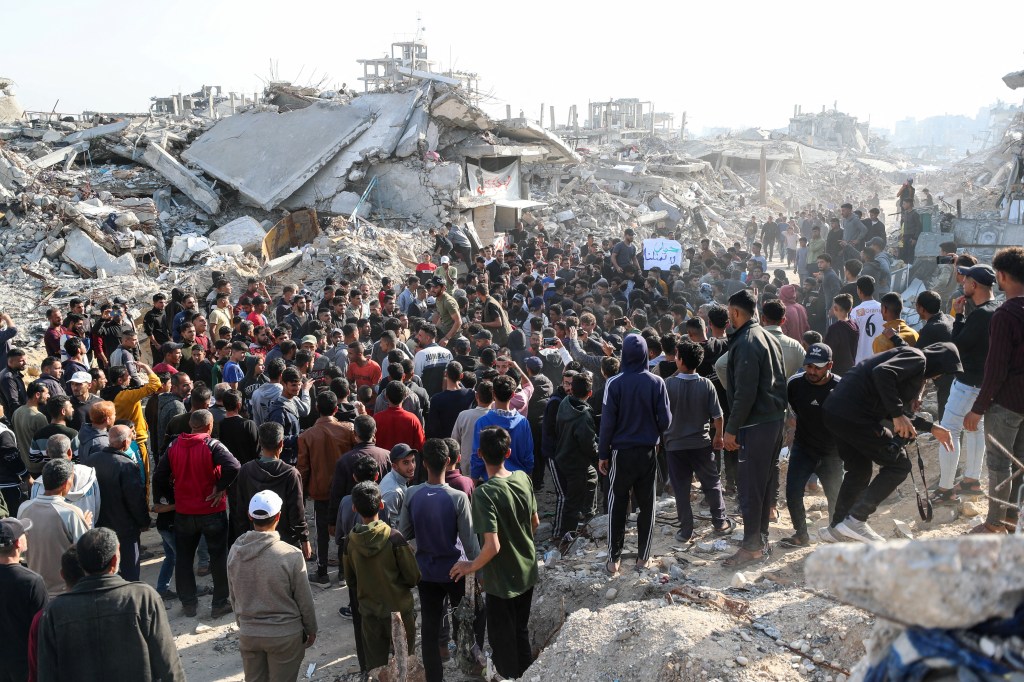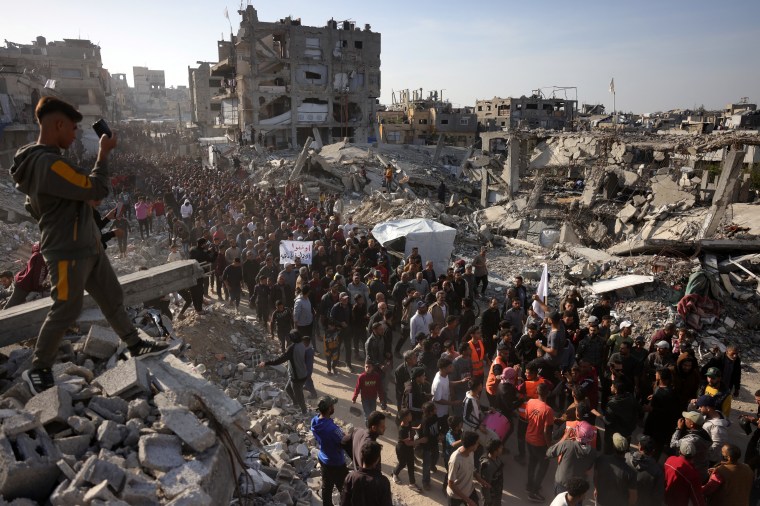New York, May 15, 2025—When Gazan journalist Tawfiq Abu Jarad received a phone call from a Hamas security agent warning him not to cover a protest, he readily complied, having been assaulted by Hamas-affiliated forces once before.
The April 27 women’s anti-war demonstration in northern Gaza’s Beit Lahia was small but significant — one of several recent protests criticizing Hamas, which has controlled Gaza with an iron fist since ousting its political rival Fatah in 2007. Designated a terrorist organization by many Western governments, Hamas is known for violently targeting and killing its critics.
“They even told me that I would be responsible if my wife participated in the demonstration,” said Abu Jarad, a 44-year-old correspondent for Ramallah-based privately owned Sawt al-Hurriya radio station. “I have not covered any recent demonstrations,” he concluded, recalling how he was beaten and interrogated for hours by Hamas-affiliated masked assailants in the southern city of Rafah in November 2023, accusing him of “covering events in the Gaza Strip calling for a coup.”
He only secured his freedom with a promise to stop reporting.
Another journalist told The Washington Post they feared covering highly unusual demonstrations in March 2025 would lead Hamas to accuse them of spying for Israel. A third said Hamas’ internal security agents sometimes followed journalists as they reported. Both spoke on the condition of anonymity.
Their fears of reporting on opposition to Hamas seem well-founded. A statement by Palestinian Resistance Factions and Tribes in Gaza, which includes Hamas, condemned the protesters as “collaborators with Israel,” a charge historically used to justify executions. Israeli outlets said that Hamas had killed Palestinians who participated in the March anti-war protests.
In an interview with Reuters news agency, a Palestinian official from a Hamas-allied militant group condemned “suspicious figures” who tried “to exploit legitimate protests to demand an end to the resistance” against Israel’s occupation of Gaza. Armed, masked Hamas militants forcibly dispersed some protesters and assaulted them, according to the BBC.

Spies and journalists are ‘one and the same’
Abu Jarad reported Hamas’ threat against himself and his wife to the Palestinian Journalists’ Syndicate (PJS), the official union for Palestinian journalists, and PJS publicly condemned Hamas for violating press freedom.
Prior to this, PJS had only published one other incident involving Hamas during the war — the brutal assault of Ibrahim Muhareb, who was beaten unconscious by armed men in plainclothes who said they were from the police investigations department. He sustained deep head wounds.
“Without giving any reason, they tried to assault me,” said Muhareb, a freelance photographer for the local Quds Feed media network and the Turkish state-owned broadcaster TRT, who was working from a tent next to southern Gaza’s Nasser Hospital.
“When I tried to contact a police officer in charge of journalists’ affairs, they tried to dismantle my tent. When I resisted, they began assaulting me, by kicking me,” the 28-year-old said.
“I tried to speak to them calmly, but they began to beat me even more severely. They suddenly struck me with an instrument, causing me to lose consciousness, and blood flowed from my head,” he told CPJ.
“Some colleagues tried to intervene, but they prevented them, literally telling them that ‘the spy and the journalist are one and the same,'” Muhareb said.
Muharab said he tried to lift a cover put over his head and face but the officers threatened him with a gun. Eventually, some journalists pulled him free and sought medical treatment for wounds all over his body.
Muharab’s experience is not unusual — it’s his decision to go public that marks him out.
“There are major violations committed by the Hamas government and group against journalists,” PJS’ head Nasser Abu Bakr told CPJ. “The violations range from summonses, interrogations, phone calls, threats, sometimes beatings and arrests, to harassment, publication bans, interference with content, and surveillance.”

Violations by Hamas are underreported
For almost two decades, CPJ has documented multiple press freedom violations by Hamas — as well as all the other warring parties in Israel and the Occupied Palestinian Territories — including detentions, assaults, obstruction, and raids.
The war in Gaza has been the deadliest period for journalists since CPJ started keeping records in 1992, with at least 178 journalists among some 52,000 Palestinians killed since Hamas’ deadly October 7, 2023, attack on Israel. An overwhelming majority of these killings, arrests, and threats were carried out by Israeli forces.
Meanwhile, press freedom violations by Hamas during the war have been vastly underreported.
PJS often documents Hamas attacks on the media internally, without publicizing them, for fear of reprisals, the group told CPJ. In other cases, PJS staff hear about events secondhand as journalists are too scared to report them.
CPJ’s experience echoes that of PJS.
In separate incidents this year, two Gaza-based journalists told CPJ that they were intimidated by Hamas security agents who blocked them from reporting in certain areas. The journalists did not consent to CPJ going public about their experiences for fear of retaliation. To them, the priority was to be able to continue reporting from the field.
More recently, a TV crew told CPJ they were assaulted by Hamas security forces while trying to film. But, again, the journalists did not want CPJ to publicize the incident as it was later resolved between the powerful clans that wield influence over most of Gaza’s population.
PJS’ deputy head Tahseen al-Astal told CPJ that Palestinian journalists are reluctant to spotlight their own problems, driven by a collective desire not to “pivot eyes from the war in Gaza,” which they felt was a more pressing story.
“Most journalists have begun to practice self-censorship in their writing to avoid any problems with security,” he added.
Mohammed Abu Aoun is another of the few journalists willing to speak publicly.
A correspondent for Fatah-affiliated Awda TV, Abu Aoun told CPJ that he was beaten by Hamas’ Internal Security Force in 2024 while interviewing a woman near Al-Aqsa Martyrs Hospital in central Gaza’s Deir al-Balah.
“During the interview, the woman insulted Hamas and some of its leaders. The officers immediately took me to an unknown location and beat me,” said Abu Aoun, 26, adding that they searched his cell phone and told him to stop working in the vicinity of the hospital.
In response to CPJ inquiries, Ismail Al-Thawabta, Director General of the Government Media Office in Gaza, said the government had received no media complaints regarding “threats related to covering protests or public gatherings,” threats from security personnel, or summonses from internal security agents.
Al-Thawabta said the government had “fully opened the field” for media to cover events freely in a “safe, transparent” environment and it was committed to “ensuring that security agencies do not interfere with the content of media coverage or the work of journalists.”
